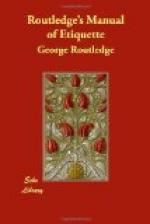Contrast these with the little caps which ornament the head with lace, as only lace can ornament it, and you will see at once how superior the present fashion is. It is not only that these pretty and mysterious fabrics of lace and ribbon are an ornament to the loveliest and most youthful; but they have worked a revolution in the caps of elderly ladies. Instead of the cap with its frill of blonde intermixed with narrow ribbon or small flowers, fitting close to the face like a fringe and tying under the chin, we see small and becoming head dresses of lace, which sufficiently furnish the cheeks and cover the hair. Where it can be done, the cap of the most elderly woman should appear to dress and furnish her head rather than her face, though, if need be, it can be made to soften the asperities of age where they have marked the countenance.
Mantles or cloaks are a difficult question.
When everybody of every station wears a cloak or mantle we are disposed to recommend shawls, especially as a really good Indian shawl cannot be imitated, and denotes the quality and condition of the wearer. Every servant girl, every maid of all work, has her Sunday cloak. None but the rich can sport an Indian shawl. It requires falling shoulders and a tall and graceful figure. It should not be fastened round the throat as if the wearer suffered from a severe cold in her throat; but it should have the appearance of being loosely put on; neither fastened tightly on, nor falling off. Square shawls are always more ugly than not. If the wearer has not a very erect carriage, and if her shoulders are not well thrown back, the chances are that the effect of a square shawl will be anything but pleasing. If the lady stoops, or is at all round-shouldered, the shawl will have the effect of a window that has been cracked by a stone—it will look starred—it will not be smooth and even, but will present the appearance of lines radiating from the defective shoulders. For grace there is nothing like a scarf shawl, but only a few can, or know how to, wear it.
Under these circumstances a cloak or a mantle are safer. There is an infinite variety to choose from, but as the names and the fashion vary year by year it is useless to specify any. For the same reason, this constant change, it is best not to invest much capital in the purchase of one. Young people can wear smaller and shorter mantles than their elders, who require something larger and more imposing.
In winter there is nothing to compare to a seal skin; so much so that even an imitation is not to be despised. Velvets are ladylike, but they are expensive, and have not the durability of a seal skin. Velveteen cloaks are good and reasonable. Blue cloth or serge, braided with black, look well, and have been in favour for some time. We have seen a grey cloth cloak braided with black which has been much admired; also one of dark green cloth lined with grey, and, vice versa, of grey lined with green. For winter, the effect of lining a cloth cloak with another colour in good contrast is decidedly good. But everything depends upon the shape and cut of the cloak. It is the shape that tells far more than the material.




